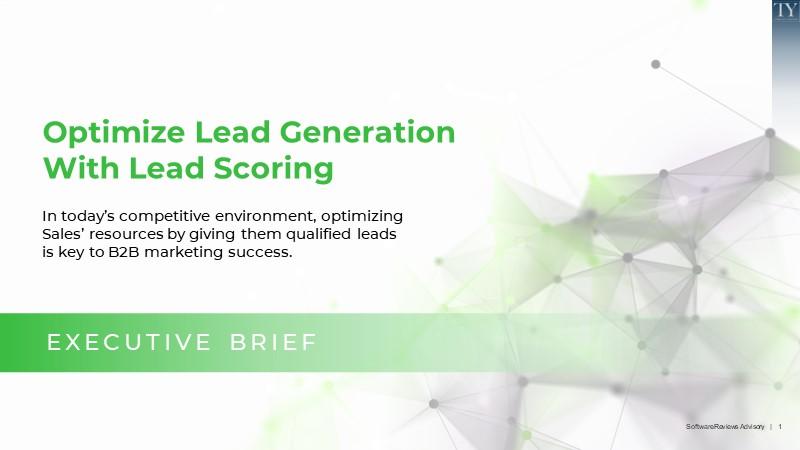
Optimize Lead Generation With Lead Scoring
- Prospective buyer traffic into digital marketing platforms has exploded.
- Many freemium/low-cost digital marketing platforms lack lead scoring and nurturing functionality.
- As a result, the volume of unqualified leads being delivered to outbound sellers has increased dramatically.
- This has reduced sales productivity, frustrated prospective buyers, and raised the costs of lead generation.
Our Advice
Critical Insight
- Lead scoring is a must-have capability for high-tech marketers.
- Without lead scoring, marketers will see increased costs of lead generation and decreased SQL-to-opportunity conversion rates.
- Lead scoring increases sales productivity and shortens sales cycles.
Impact and Result
- Align Marketing, Sales, and Inside Sales on your ideal customer profile.
- Re-evaluate the assets and activities that compose your current lead generation engine.
- Develop a documented methodology to ignore, nurture, or contact right away the leads in your marketing pipeline.
- Deliver more qualified leads to sellers, raising sales productivity and marketing/lead-gen ROI.
Optimize Lead Generation With Lead Scoring Research & Tools
Start here – read the Executive Brief
Read our concise Executive Brief to find out why you should optimize lead generation with lead scoring, review SoftwareReviews Advisory’s methodology, and understand the four ways we can support you in completing this project.Besides the small introduction, subscribers and consulting clients within this management domain have access to:
- Optimize Lead Generation With Lead Scoring – Phases 1-3
1. Drive aligned vision for lead scoring
Outline your plan, form your team, and plan marketing tech stack support.
- Optimize Lead Generation With Lead Scoring – Phase 1: Drive an Aligned Vision for Lead Scoring
2. Build and test your lead scoring model
Set lead flow thresholds, define your ideal customer profile and lead generation engine components, and weight, score, test, and refine them.
- Optimize Lead Generation With Lead Scoring – Phase 2: Build and Test Your Lead Scoring Model
- Lead Scoring Workbook
3. Apply your model to marketing apps and go live with better qualified leads
Apply your lead scoring model to your lead management app, test it, validate the results with sellers, apply advanced methods, and refine.
- Optimize Lead Generation With Lead Scoring – Phase 3: Apply Your Model to Marketing Apps and Go Live With Better Qualified Leads
Workshop: Optimize Lead Generation With Lead Scoring
Workshops offer an easy way to accelerate your project. If you are unable to do the project yourself, and a Guided Implementation isn't enough, we offer low-cost delivery of our project workshops. We take you through every phase of your project and ensure that you have a roadmap in place to complete your project successfully.
1 Drive Aligned Vision for Lead Scoring
The Purpose
Drive an aligned vision for lead scoring.
Key Benefits Achieved
Attain an aligned vision for lead scoring.
Identify the steering committee and project team and clarify their roles and responsibilities.
Provide your team with an understanding of how leads score through the marketing funnel.
Activities
1.1 Outline a vision for lead scoring.
1.2 Identify steering committee and project team members.
1.3 Assess your tech stack for lead scoring and seek advice from Info-Tech analysts to modernize where needed.
1.4 Align on marketing pipeline terminology.
Outputs
Steering committee and project team make-up
Direction on tech stack to support lead generation
Marketing pipeline definitions alignment
2 Buyer Journey and Lead Generation Engine Mapping
The Purpose
Define the buyer journey and map the lead generation engine.
Key Benefits Achieved
Align the vision for your target buyer and their buying journey.
Identify the assets and activities that need to compose your lead generation engine.
Activities
2.1 Establish a buyer persona.
2.2 Map your buyer journey.
2.3 Document the activities and assets of your lead generation engine.
Outputs
Buyer persona
Buyer journey map
Lead gen engine assets and activities documented
3 Build and Test Your Lead Scoring Model
The Purpose
Build and test your lead scoring model.
Key Benefits Achieved
Gain team alignment on how leads score and, most importantly, what constitutes a sales-accepted lead.
Develop a scoring model from which future iterations can be tested.
Activities
3.1 Understand the Lead Scoring Grid and set your thresholds.
3.2 Identify your ideal customer profile, attributes, and subattribute weightings – run tests.
Outputs
Lead scoring thresholds
Ideal customer profile, weightings, and tested scores
Test profile scoring
4 Align on Engagement Attributes
The Purpose
Align on engagement attributes.
Key Benefits Achieved
Develop a scoring model from which future iterations can be tested.
Activities
4.1 Weight the attributes of your lead generation engagement model and run tests.
4.2 Apply weightings to activities and assets.
4.3 Test engagement and profile scenarios together and make any adjustments to weightings or thresholds.
Outputs
Engagement attributes and weightings tested and complete
Final lead scoring model
5 Apply Model to Your Tech Platform
The Purpose
Apply the model to your tech platform.
Key Benefits Achieved
Deliver better qualified leads to Sales.
Activities
5.1 Apply model to your marketing management/campaign management software and test the quality of sales-accepted leads in the hands of sellers.
5.2 Measure overall lead flow and conversion rates through your marketing pipeline.
5.3 Apply lead nurturing and other advanced methods.
Outputs
Model applied to software
Better qualified leads in the hands of sellers
Further reading
Optimize Lead Generation With Lead Scoring
In today’s competitive environment, optimizing Sales’ resources by giving them qualified leads is key to B2B marketing success.
EXECUTIVE BRIEF
Analyst Perspective
Improve B2B seller win rates with a lead scoring methodology as part of your modern lead generation engine.

As B2B organizations emerge from the lowered demands brought on by COVID-19, they are eager to convert marketing contacts to sales-qualified leads with even the slightest signal of intent, but many sales cycles are wasted when sellers receive unqualified leads. Delivering highly qualified leads to sellers is still more art than science, and it is especially challenging without a way to score a contact profile and engagement. While most marketers capture some profile data from contacts, many will pass a contact over to Sales without any engagement data or schedule a demo with a contact without any qualifying profile data. Passing unqualified leads to Sales suboptimizes Sales’ resources, raises the costs per lead, and often results in lost opportunities. Marketers need to develop a lead scoring methodology that delivers better qualified leads to Field Sales scored against both the ideal customer profile (ICP) and engagement that signals lower-funnel buyer interest. To be successful in building a compelling lead scoring solution, marketers must work closely with key stakeholders to align the ICP asset/activity with the buyer journey. Additionally, working early in the design process with IT/Marketing Operations to implement lead management and analytical tools in support will drive results to maximize lead conversion rates and sales wins.
Jeff Golterman
Managing Director
SoftwareReviews Advisory
Executive Summary
Your Challenge
The affordability and ease of implementation of digital marketing tools have driven global adoption to record levels. While many marketers are fine-tuning the lead generation engine components of email, social media, and web-based advertising to increase lead volumes, just 32% of companies pass well-qualified leads over to outbound marketers or sales development reps (SDRs). At best, lead gen costs stay high, and marketing-influenced win rates remain suboptimized. At worst, marketing reputation suffers when poorly qualified leads are passed along to sellers.
Common Obstacles
Most marketers lack a methodology for lead scoring, and some lack alignment among Marketing, Product, and Sales on what defines a qualified lead. In their rush to drive lead generation, marketers often fail to “define and align” on the ICP with stakeholders, creating confusion and wasted time and resources. In the rush to adopt B2B marketing and sales automation tools, many marketers have also skipped the important steps to 1) define the buyer journey and map content types to support, and 2) invest in a consistent content creation and sourcing strategy. The wrong content can leave prospects unmotivated to engage further and cause them to seek alternatives.
Info-Tech’s Approach
To employ lead scoring effectively, marketers need to align Sales, Marketing, and Product teams on the definition of the ICP and what constitutes a Sales-accepted lead. The buyer journey needs to be mapped in order to identify the engagement that will move a lead through the marketing lead generation engine. Then the project team can score prospect engagement and the prospect profile attributes against the ICP to arrive at a lead score. The marketing tech stack needs to be validated to support lead scoring, and finally Sales needs to sign off on results.
SoftwareReviews Advisory Insight:
Lead scoring is a must-have capability for high-tech marketers. Without lead scoring, marketers will see increased costs of lead gen, decreased SQL to opportunity conversion rates, decreased sales productivity, and longer sales cycles.
Who benefits from a lead scoring project?
This Research Is Designed for:
- Marketers and especially campaign managers who are:
- Looking for a more precise way to score leads and deploy outbound marketing resources to optimize contacts-to-MQL conversion rates.
- Looking for a more effective way to profile contacts raised by your lead gen engine.
- Looking to use their lead management software to optimize lead scoring.
- Starting anew to strengthen their lead generation engine and want examples of a typical engine, ways to identify buyer journey, and perform lead nurturing.
This Research Will Help You:
- Explain why having a lead scoring methodology is important.
- Identify a methodology that will call for identifying an ICP against which to score prospect profiles behind each contact that engages your lead generation engine.
- Create a process of applying weightings to score activities during contact engagement with your lead generation engine. Apply both scores to arrive at a contact/lead score.
- Compare your current lead gen engine to a best-in-class example in order to identify gaps and areas for improvement and exploration.
This Research Will Also Assist:
- CMOs, Marketing Operations leaders, heads of Product Marketing, and regional Marketing leads who are stakeholders in:
- Finding alternatives to current lead scoring approaches.
- Altering current or evaluating new marketing technologies to support a refreshed lead scoring approaches.
This Research Will Help Them:
- Align stakeholders on an overall program of identifying target customers, building common understanding of what constitutes a qualified lead, and determining when to use higher-cost outbound marketing resources.
- Deploy high-value applications that will improve core marketing metrics.
Insight summary
Continuous adjustment and improvement of your lead scoring methodology is critical for long-term lead generation engine success.
- Building a highly functioning lead generation engine is an ongoing process and one that requires continual testing of new asset types, asset design, and copy variations. Buyer profiles change over time as you launch new products and target new markets.
- Pass better qualified leads to Field Sales and improve sales win rates by taking these crucial steps to implement a better lead generation engine and a lead scoring methodology:
- Make the case for lead scoring in your organization.
- Establish trigger points that separate leads to ignore, nurture, qualify, or outreach/contact.
- Identify your buyer journey and ICP through collaboration among Sales, Marketing, and Product.
- Assess each asset and activity type across your lead generation engine and apply a weighting for each.
- Test lead scenarios within our supplied toolkit and with stakeholders. Adjust weightings and triggers that deliver lead scores that make sense.
- Work with IT/Marketing Operations to emulate your lead scoring methodology within your marketing automation/campaign management application.
- Explore advanced methods including nurturing.
- Use the Lead Scoring Workbook collaboratively with other stakeholders to design your own methodology, test lead scenarios, and build alignment across the team.
Leading marketers who successfully implement a lead scoring methodology develop it collaboratively with stakeholders across Marketing, Sales, and Product Management. Leaders will engage Marketing Operations, Sales Operations, and IT early to gain support for the evaluation and implementation of a supporting campaign management application and for analytics to track lead progress throughout the Marketing and Sales funnels. Leverage the Marketing Lead Scoring Toolkit to build out your version of the model and to test various scenarios. Use the slides contained within this storyboard and the accompanying toolkit as a means to align key stakeholders on the ICP and to weight assets and activities across your marketing lead generation engine.
What is lead scoring?
Lead scoring weighs the value of a prospect’s profile against the ICP and renders a profile score. The process then weighs the value of the prospects activities against the ideal call to action (CTA) and renders an activity score. Combining the profile and activity scores delivers an overall score for the value of the lead to drive the next step along the overall buyer journey.
EXAMPLE: SALES MANAGEMENT SOFTWARE
- For a company that markets sales management software the ideal buyer is the head of Sales Operations. While the ICP is made up of many attributes, we’ll just score one – the buyer’s role.
- If the prospect/lead that we wish to score has an executive title, the lead’s profile scores “High.” Other roles will score lower based on your ICP. Alongside role, you will also score other profile attributes (e.g. company size, location).
- With engagement, if the prospect/lead clicked on our ideal CTA, which is “request a proposal,” our engagement would score high. Other CTAs would score lower.
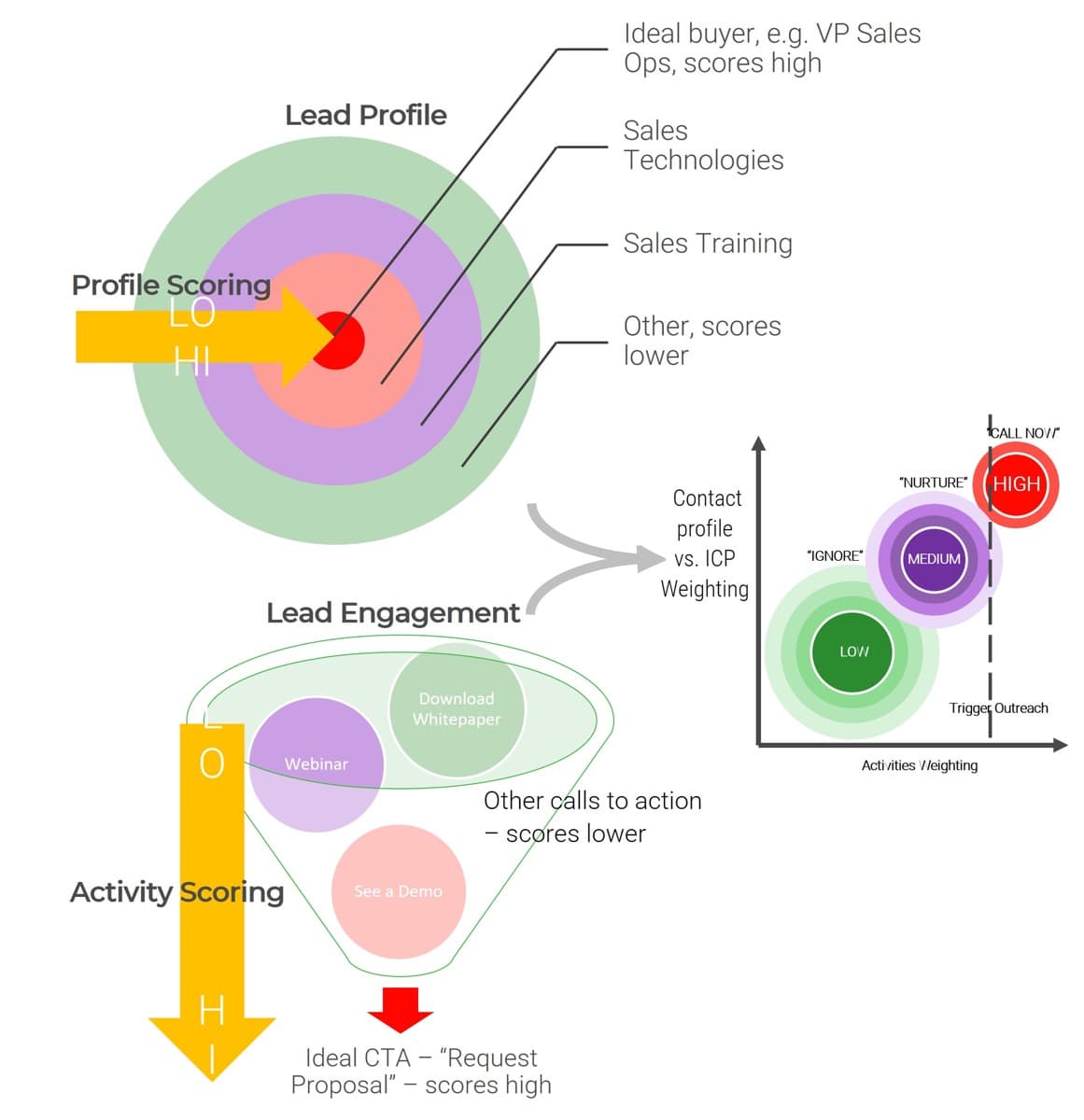
SoftwareReviews Advisory Insight:
A significant obstacle to quality lead production is disagreement on or lack of a documented definition of the ideal customer profile. Marketers successful in lead scoring will align key stakeholders on a documented definition of the ICP as a first step in improving lead scoring.
Use of lead scoring is in the minority among marketers
The majority of businesses are not practicing lead scoring!
Up to 66% of businesses don’t practice any type of lead scoring.
Source: LeadSquared, 2014
“ With lead scoring, you don’t waste loads of time on unworthy prospects, and you don’t ignore people on the edge of buying.”
Source: BigCommerce
“The benefits of lead scoring number in the dozens. Having a deeper understanding of which leads meet the qualifications of your highest converters and then systematically communicating with them accordingly increases both ongoing engagement and saves your internal team time chasing down inopportune leads.”
– Joey Strawn, Integrated Marketing Director, in IndustrialMarketer.com
Key benefit: sales resource optimization
Many marketing organizations send Sales too many unqualified leads
- Leads – or, more accurately, contacts – are not all qualified. Some are actually nothing more than time-wasters for sellers.
- Leading marketers peel apart a contact into at least two dimensions – “who” and “how interested.”
- The “who” is compared to the ICP and given a score.
- The “how interested” measures contact activity – or engagement – within our lead gen engine and gives it a score.
- Scores are combined; a contact with a low score is ignored, medium is nurtured, and high is sent to sellers.
- A robust ICP, together with engagement scoring and when housed within your lead management software, prioritizes for marketers which contacts to nurture and gets hot leads to sellers more quickly.
Optimizing Sales Resources Using Lead Scoring
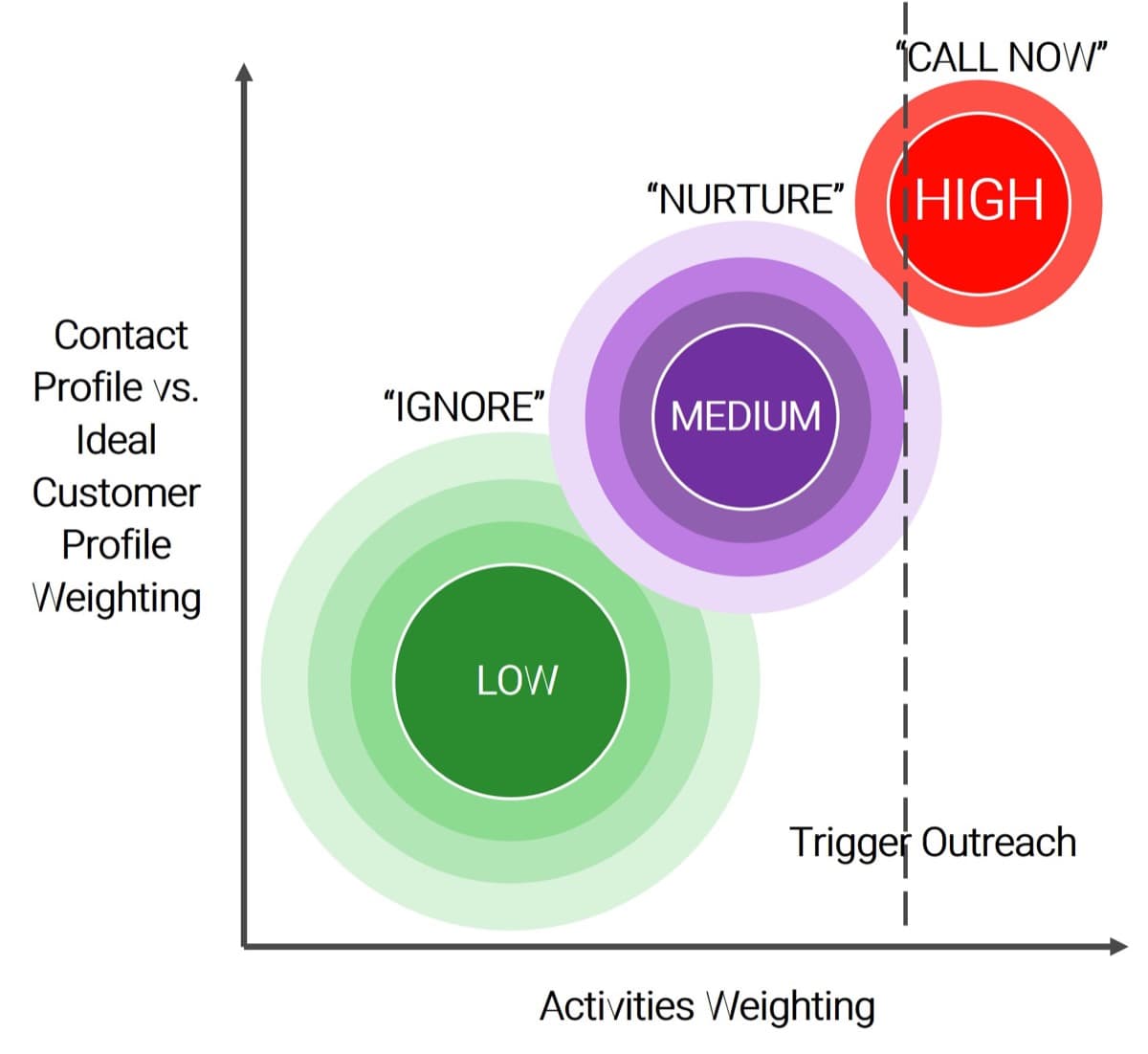
Lead scoring drives greater sales effectiveness
When contacts are scored as “qualified leads” and sent to sellers, sales win rates and ROI climb
- Contacts can be scored properly once marketers align with Sales on the ICP and work closely with colleagues in areas like product marketing and field marketing to assign weightings to lead gen activities.
- When more qualified leads get into the hands of the salesforce, their win rates improve.
- As win rates improve, and sellers are producing more wins from the same volume of leads, sales productivity improves and ROI on the marketing investment increases.
“On average, organizations that currently use lead scoring experience a 77% lift in lead generation ROI, over organizations that do not currently use lead scoring.”
– MarketingSherpa, 2012
Average Lead Generation ROI by Use of Lead Scoring
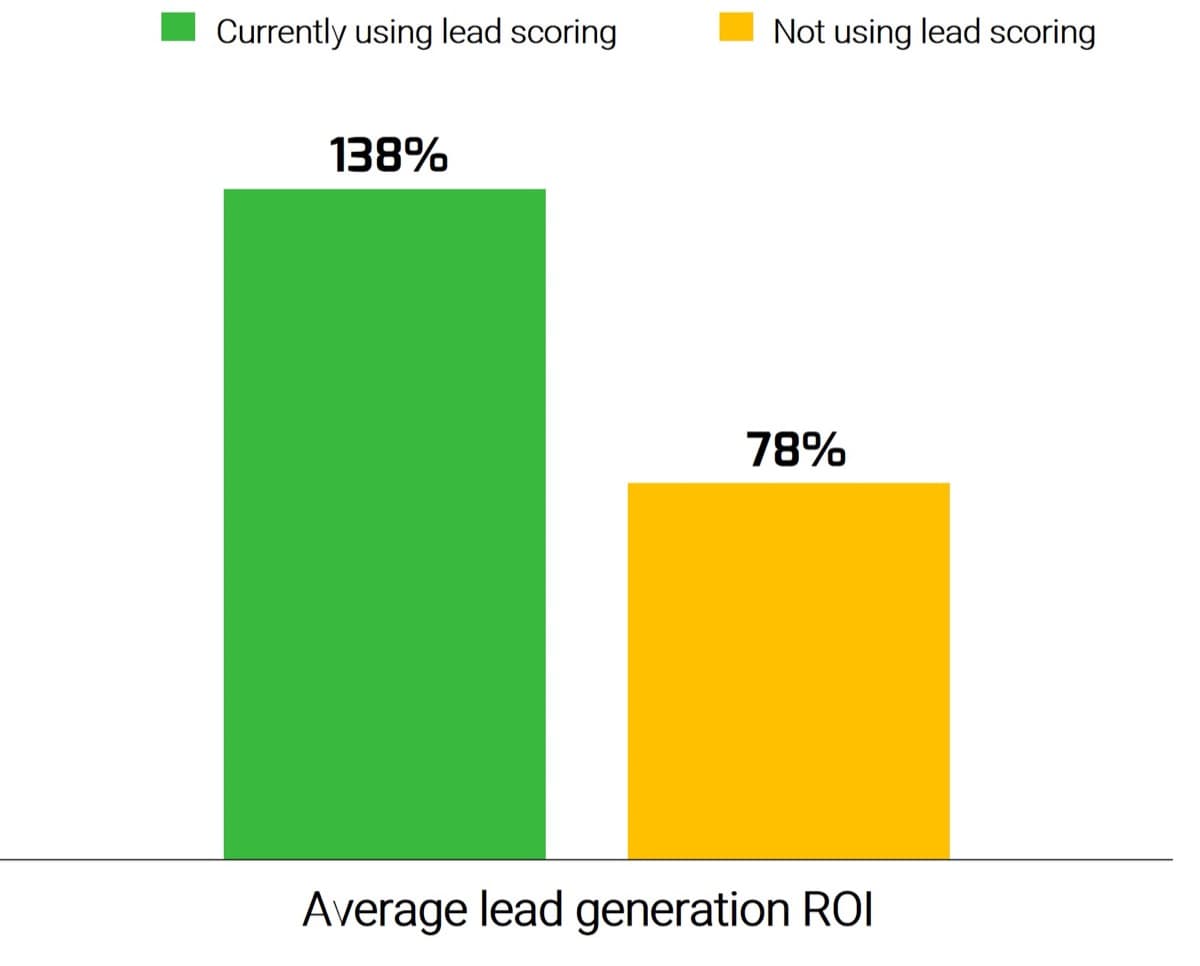
Source: 2011 B2B Marketing Benchmark Survey, MarketingSherpa
Methodology: Fielded June 2011, N=326 CMOs
SoftwareReviews’ Lead Scoring Approach
1. Drive Aligned Vision for Lead Scoring |
2. Build and Test Your Lead Scoring Model |
3. Apply to Your Tech Platform and Validate, Nurture, and Grow |
|
Phase |
|
|
|
Phase Outcomes |
|
|
|
Key Deliverable: Lead Scoring Workbook
The workbook walks you through a step-by-step process to:
- Identify your team.
- Identify the lead scoring thresholds.
- Define your IPC.
- Weight the activities within your lead generation engine.
- Run tests using lead scenarios.
Tab 1: Team Composition
Consider core functions and form a cross-functional lead scoring team. Document the team’s details here.
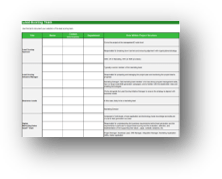
Tab 2: Threshold Setting
Set your initial threshold weightings for profile and engagement scores.
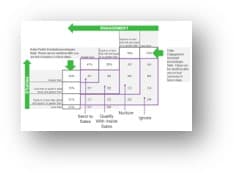
Tab 3:
Establish Your Ideal Customer Profile
Identify major attributes and attribute values and the weightings of both. You’ll eventually score your leads against this ICP.
Record and Weight Lead Gen Engine Activities
Identify the major activities that compose prospect engagement with your lead gen engine. Weight them together as a team.
Test Lead Profile Scenarios
Test actual lead profiles to see how they score against where you believe they should score. Adjust threshold settings in Tab 2.
Test Activity Engagement Scores
Test scenarios of how contacts navigate your lead gen engine. See how they score against where you believe they should score. Adjust thresholds on Tab 2 as needed.
Review Combined Profile and Activity Score
Review the combined scores to see where on your lead scoring matrix the lead falls. Make any final adjustments to thresholds accordingly.
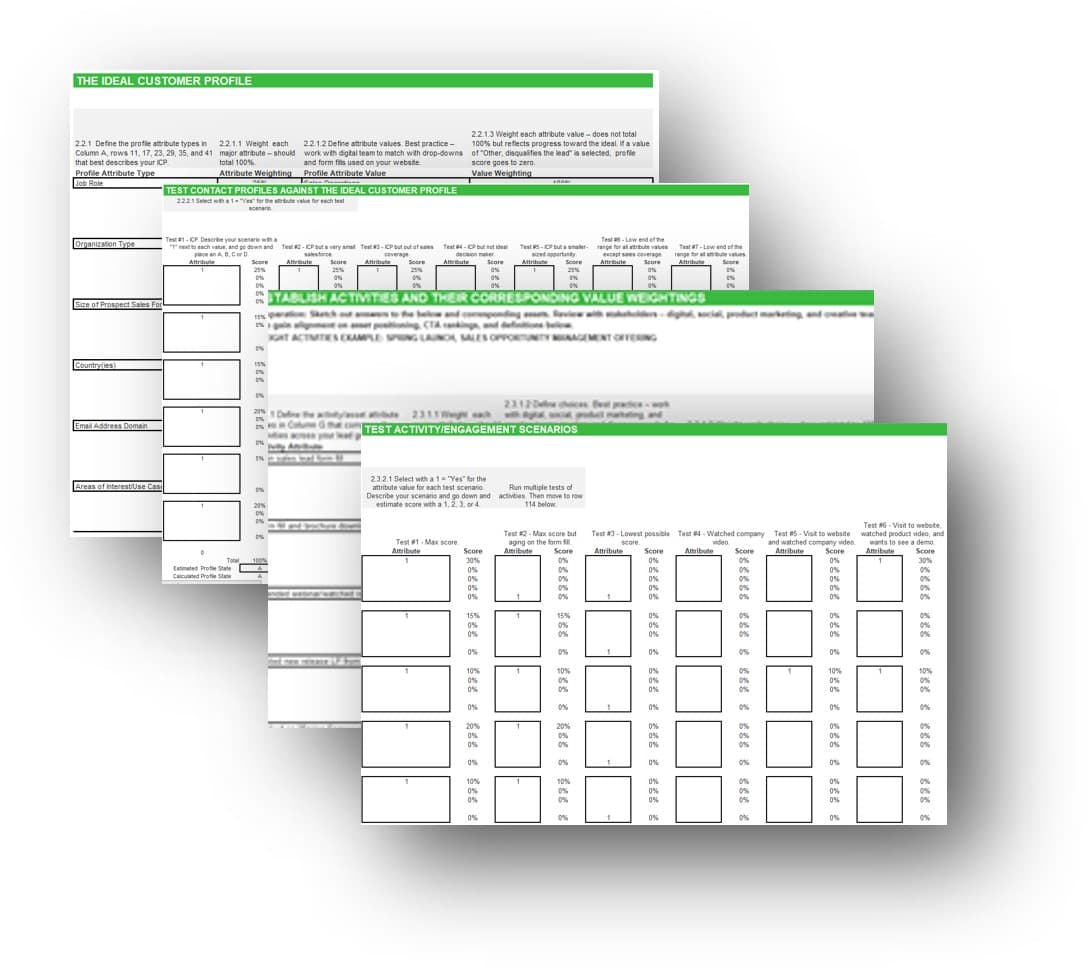
Several ways we help you build your lead scoring methodology
| DIY Toolkit | Guided Implementation | Workshop | Consulting |
|---|---|---|---|
"Our team has already made this critical project a priority, and we have the time and capability, but some guidance along the way would be helpful." |
"Our team knows that we need to fix a process, but we need assistance to determine where to focus. Some check-ins along the way would help keep us on track." |
"We need to hit the ground running and get this project kicked off immediately. Our team has the ability to take this over once we get a framework and strategy in place." |
"Our team does not have the time or the knowledge to take this project on. We need assistance through the entirety of this project." |
|
|
|
|
Guided Implementation
What does a typical GI on this topic look like?
Phase 1 |
Phase 2 |
Phase 3 |
|---|---|---|
|
Call #1: Collaborate on vision for lead scoring and the overall project. Call #2: Identify the steering committee and the rest of the team. Call #3: Discuss app/tech stack support for lead scoring. Understand key marketing pipeline terminology and the buyer journey. Call #4: Discuss your ICP, apply weightings, and run test scenarios. |
Call #5: Discuss and record lead generation engine components. Call #6: Understand the Lead Scoring Grid and set thresholds for your model. Call #7: Identify your ICP, apply weightings to attributes, and run tests. |
Call #8: Weight the attributes of engagement activities and run tests. Review the application of the scoring model on lead management software. Call #9: Test quality of sales-accepted leads in the hands of sellers. Measure lead flow and conversion rates through your marketing pipeline. Call #10: Review progress and discuss nurturing and other advanced topics. |
A Guided Implementation (GI) is series of calls with a SoftwareReviews Advisory analyst to help implement our best practices in your organization. For guidance on marketing applications, we can arrange a discussion with an Info-Tech analyst. Your engagement managers will work with you to schedule analyst calls.
Workshop Overview
Accelerate your project with our facilitated SoftwareReviews Advisory workshops
Day 1 |
Day 2 |
Day 3 |
Day 4 |
Day 5 |
|
|---|---|---|---|---|---|
Drive Aligned Vision for Lead Scoring |
Buyer Journey and Lead Gen Engine Mapping |
Build and Test Your Lead Scoring Model |
Align on Engagement Attributes |
Apply to Your Tech Platform |
|
Activities |
1.1 Outline a vision for lead scoring. 1.2 Identify steering committee and project team members. 1.3 Assess your tech stack for lead scoring and seek advice from Info-Tech analysts to modernize where needed. 1.4 Align on marketing pipeline terminology. |
2.1 Establish a buyer persona (if not done already). 2.2 Map your buyer journey. 2.3 Document the activities and assets of your lead gen engine. |
3.1 Understand Lead Scoring Grid and set your thresholds. 3.2 Identify ICP attribute and sub-attribute weightings. Run tests. |
4.1 Weight the attributes of your lead gen engagement model and run tests. 4.2 Apply weightings to activities and assets. 4.3 Test engagement and profile scenarios together and adjust weightings and thresholds as needed. |
5.1 Apply model to your campaign management software and test quality of sales-accepted leads in the hands of sellers. 5.2. Measure overall lead flow and conversion rates through your marketing pipeline. 5.3 Apply lead nurturing and other advanced methods. |
Deliverables |
|
|
|
|
|
Phase 1
Drive an Aligned Vision for Lead Scoring
Phase 1 |
Phase 2 |
Phase 3 |
|---|---|---|
1.1 Establish a cross-functional vision for lead scoring 1.2 Asses your tech stack for lead scoring (optional) 1.3 Catalog your buyer journey and lead gen engine assets |
2.1 Start building your lead scoring model 2.2 Identify and verify your IPC and weightings 2.3 Establish key lead generation activities and assets |
3.1 Apply model to your marketing management software 3.2 Test the quality of sales-accepted leads 3.3 Apply advanced methods |
This phase will walk you through the following activities:
- Solidify your vision for lead scoring.
- Achieve stakeholder alignment.
- Assess your tech stack.
This phase involves the following stakeholders:
- Field Marketing/Campaign Manager
- CMO
- Product Marketing
- Product Management
- Sales Leadership/Sales Operations
- Inside Sales leadership
- Marketing Operations/IT
- Digital Platform leadership
Step 1.1
Establish a Cross-Functional Vision for Lead Scoring
Activities
1.1.1 Identify stakeholders critical to success
1.1.2 Outline the vision for lead scoring
1.1.3 Select your lead scoring team
This step will walk you through the following activities:
- Discuss the reasons why lead scoring is important.
- Review program process.
- Identify stakeholders and team.
This step involves the following participants:
- Stakeholders
- Project sponsors and leaders
Outcomes of this step
- Stakeholder alignment on vision of lead scoring
- Stakeholders described and team members recorded
- A documented buyer journey and map of your current lead gen engine
1.1.1 Identify stakeholders critical to success
1 hour
- Meet to identify the stakeholders that should be included in the project’s steering committee.
- Finalize selection of steering committee members.
- Contact members to ensure their willingness to participate.
- Document the steering committee members and the milestone/presentation expectations for reporting project progress and results
| Input | Output |
|
|
| Materials | Participants |
|
|
SoftwareReviews Advisory Insight:
B2B marketers that lack agreement among Marketing, Sales, Inside Sales, and lead management supporting staff of what constitutes a qualified lead will squander precious time and resources throughout the customer acquisition process.
1.1.2 Outline the vision for lead scoring
1 hour
- Convene a meeting of the steering committee and initiative team members who will be involved in the lead scoring project.
- Using slides from this blueprint, understand the definition of lead scoring, the value of lead scoring to the organization, and the overall lead scoring process.
- Understand the teams’ roles and responsibilities and help your Marketing Operations/IT colleagues understand some of the technical requirements needed to support lead scoring.
- This is important because as the business members of the team are developing the lead scoring approach on paper, the technical team can begin to evaluate lead management apps within which your lead scoring model will be brought to life.
| Input | Output |
|
|
| Materials | Participants |
|
|
SoftwareReviews Advisory Insight:
While SMBs can implement some form of lead scoring when volume is very low and leads can be scored by hand, lead scoring and effective lead management cannot be performed without investment in digital platforms and lead management software and integration with customer relationship management (CRM) applications in the hands of inside and field sales staff. Marketers should plan and budget for the right combination of applications and tools to be in place for proper lead management.
Lead scoring stakeholders
Developing a common stakeholder understanding of the ICP, the way contact profiles are scored, and the way activities and asset engagement in your lead generation engine are scored will strengthen alignment between Marketing, Sales and Product Management.
Title |
Key Stakeholders Within a Lead Generation/Scoring Initiative |
|---|---|
Lead Scoring Sponsor |
|
Lead Scoring Initiative Manager |
|
Business Leads |
|
Digital, Marketing/Sales Ops/IT Team |
|
Steering Committee |
|
SoftwareReviews Advisory Insight:
Marketers managing the lead scoring initiative must include Product Marketing, Sales, Inside Sales, and Product Management. And given that world-class B2B lead generation engines cannot run without technology enablement, Marketing Operations/IT – those that are charged with enabling marketing and sales – must also be part of the decision making and implementation process of lead scoring and lead generation.
1.1.3 Select your lead scoring team
30 minutes
- The CMO and other key stakeholders should discuss and determine who will be involved in the lead scoring project.
- Business leaders in key areas – Product Marketing, Field Marketing, Digital Marketing, Inside Sales, Sales, Marketing Ops, Product Management, and IT – should be involved.
- The size of the team will vary depending on your initiative and size of your organization.
| Input | Output |
|
|
| Materials | Participants |
|
|
Download the Lead Scoring Workbook
Lead scoring team
Consider the core team functions when composing the lead scoring team. Form a cross-functional team (i.e. across IT, Marketing, Sales, Service, Operations) to create a well-aligned lead management/scoring strategy. Don’t let your core team become too large when trying to include all relevant stakeholders. Carefully limit the size of the team to enable effective decision making while still including functional business units.
Required Skills/Knowledge |
Suggested Team Members |
|---|---|
Business |
|
|
|
IT |
|
|
|
Other |
|
|
|
Step 1.2 (Optional)
Assess Your Tech Stack for Lead Scoring
Our model assumes you have:
1.2.1 A marketing application/campaign management application in place that accommodates lead scoring.
1.2.2 Lead management software integrated with the sales automation/CRM tool in the hands of Field Sales.
1.2.3 Reporting/analytics that spans the entire lead generation pipeline/funnel.
Refer to the following three slides if you need guidance in these areas.
This step will walk you through the following activities:
- Confirm that you have your tech stack in place.
- Set up an inquiry with an Info-Tech analyst should you require guidance on evaluating lead pipeline reporting, CRM, or analytics applications.
This step involves the following participants:
- Stakeholders
- Project sponsors and leaders
Outcomes of this step
- Understanding of what new application and technology support is required to support lead scoring.
SoftwareReviews Advisory Insight:
Marketers that collaborate closely with Marketing Ops/IT early in the process of lead scoring design will be best able to assess whether current marketing applications and tools can support a full lead scoring capability.
1.2.1 Plan technology support for marketing management apps
Work with Marketing Ops and IT early to evaluate application enablement for lead management, including scoring
A thorough evaluation takes months – start early
- Work closely with Marketing Operations (or the team that manages the marketing apps and digital platforms) as early as possible to socialize your approach to lead scoring.
- Work with them on a set of updated requirements for selecting a marketing management suite or for changes to existing apps and tools to support your lead scoring approach that includes lead tracking and marketing funnel analytics.
- Access the Info-Tech blueprint Select a Marketing Management Suite, along with analyst inquiry support during the requirements definition, vendor evaluation, and vendor selection phases. Use the SoftwareReviews Marketing Management Data Quadrant during vendor evaluation and selection.
SoftwareReviews Marketing Management Data Quadrant
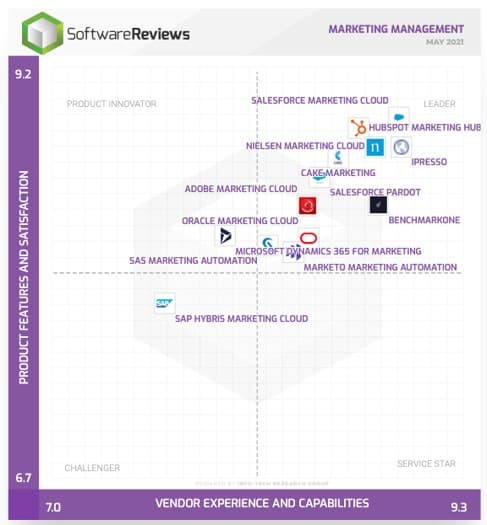
1.2.2 Plan technology support for sales opportunity management
Work with Marketing Ops and IT early to evaluate applications for sales opportunity management
A thorough evaluation takes months – start early
- Work closely with Sales Operations as early as possible to socialize your approach to lead scoring and how lead management must integrate with sales opportunity management to manage the entire marketing and sales funnel management process.
- Work with them on a set of updated requirements for selecting a sales opportunity management application that integrates with your marketing management suite or for changes to existing apps and tools to support your lead management and scoring approach that support the entire marketing and sales pipeline with analytics.
Access the Info-Tech blueprint Select and Implement a CRM Platform, along with analyst inquiry support during the requirements definition, vendor evaluation, and vendor selection phases. Use the SoftwareReviews CRM Data Quadrant during vendor evaluation and selection.
SoftwareReviews Customer Relationship Management Data Quadrant
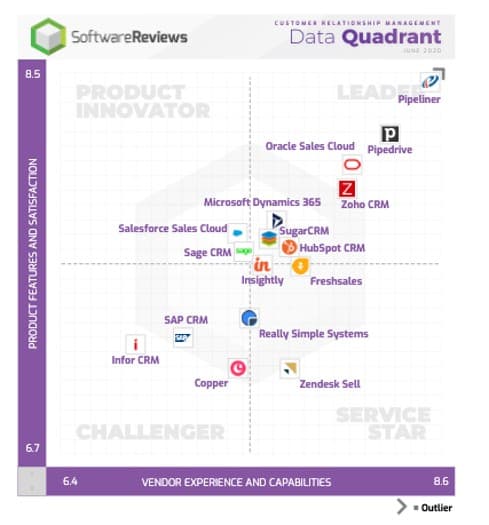
1.2.3 Plan analytics support for marketing pipeline analysis
Work with Marketing Ops early to evaluate analytics tools to measure marketing and sales pipeline conversions
A thorough evaluation takes weeks – start early
- Work closely with Marketing and Sales Operations as early as possible to socialize your approach to measuring the lifecycle of contacts through to wins across the entire marketing and sales funnel management process.
- Work with them on a set of updated requirements for selecting tools that can support the measurement of conversion ratios from contact to MQL, SQL, and opportunity to wins. Having this data enables you to measure improvement in component parts to your lead generation engine.
- Access the Info-Tech blueprint Select and Implement a Reporting and Analytics Solution, along with analyst inquiry support during the requirements definition, vendor evaluation and vendor selection phases. Use the SoftwareReviews Best Business intelligence & Analytics Software Data Quadrant as well during vendor evaluation and selection.
SoftwareReviews Business Intelligence Data Quadrant
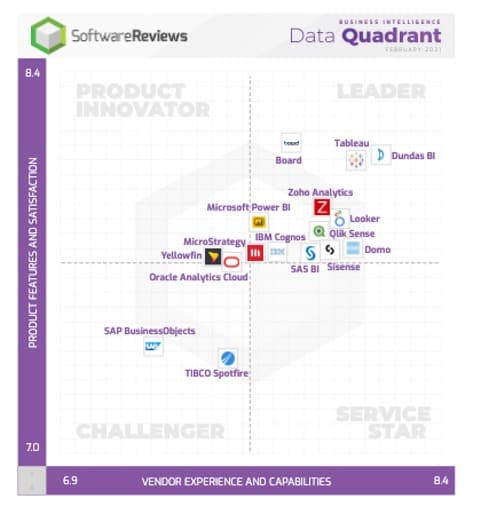
Step 1.3
Catalog Your Buyer Journey and Lead Gen Engine Assets
Activities
1.3.1 Review marketing pipeline terminology
1.3.2 Describe your buyer journey
1.3.3 Describe your awareness and lead generation engine
This step will walk you through the following activities:
- Discuss marketing funnel terminology.
- Describe your buyer journey.
- Catalog the elements of your lead generation engine.
This step involves the following participants:
- Stakeholders
Outcomes of this step
- Stakeholder alignment on terminology, your buyer journey, and elements of your lead generation engine
1.3.1 Review marketing pipeline terminology
30 minutes
- We assume for this model the following:
- Our primary objective is to deliver more, and more-highly qualified, sales-qualified leads (SQLs) to our salesforce. The salesforce will accept SQLs and after further qualification turn them into opportunities. Sellers work opportunities and turn them into wins. Wins that had first/last touch attribution within the lead gen engine are considered marketing-influenced wins.
- This model assumes the existence of sales development reps (SDRs) whose mission it is to take marketing-qualified leads (MQLs) from the lead generation engine and further qualify them into SQLs.
- The lead generation engine takes contacts – visitors to activities, website, etc. – and scores them based on their profile and engagement. If the contact scores at or above the designated threshold, the lead generation engine rates it as an MQL and passes it along to Inside Sales/SDRs. If the contact scores above a certain threshold and shows promise, it is further nurtured. If the contact score is low, it is ignored.
- If an organization does not possess a team of SDRs or Inside Sales, you would adjust your version of the model to, for example, raise the threshold for MQLs, and when the threshold is reached the lead generation engine would pass the lead to Field Sales for further qualification.
Stage |
Characteristics |
Actions |
Contact |
|
Nurture SDR Qualify Send to Sales Close |
MQL |
|
|
SQL |
|
|
Oppt’y |
|
|
Win |
|
SoftwareReviews Advisory Insight:
Score leads in a way that makes it crystal clear whether they should be ignored, further nurtured, further qualified, or go right into a sellers’ hands as a super hot lead.
1.3.2 Describe your buyer journey
- Understand the concept of the buyer journey:
- Typically Product Marketing is charged with establishing deep understanding of the target buyer for each product or solution through a complete buyer persona and buyer journey map. The details of how to craft both are covered in the upcoming SoftwareReviews Advisory blueprint Craft a More Comprehensive Go-to-Market Strategy. However, we share our Buyer Journey Template here (on the next slide) to illustrate the connection between the buyer journey and the lead generation and scoring processes.
- Marketers and campaigners developing the lead scoring methodology will work closely with Product Marketing, asking them to document the buyer journey.
- The value of the buyer journey is to guide asset/content creation, nurturing strategy and therefore elements of the lead generation engine such as web experience, email, and social content and other elements of engagement.
- The additional value of having a buyer persona is to also inform the ICP, which is an essential element of lead scoring.
- For the purposes of lead scoring, use the template on the next slide to create a simple form of the buyer journey. This will guide lead generation engine design and the scoring of activities later in our blueprint.
2 hours
On the following slide:
- Tailor this template to suit your buyer journey. Text in green is yours to modify. Text in black is instructional.
- Your objective is to use the buyer journey to identify asset types and a delivery channel that once constructed/sourced and activated within your lead gen engine will support the buyer journey.
- Keep your buyer journey updated based on actual journeys of sales wins.
- Complete different buyer journeys for different product areas. Complete these collaboratively with stakeholders for alignment.
SoftwareReviews Advisory Insight:
Establishing a buyer journey is one of the most valuable tools that, typically, Product Marketing produces. Its use helps campaigners, product managers, and Inside and Field Sales. Leading marketers keep journeys updated based on live deals and characteristics of wins.
Buyer Journey Template
Personas: [Title] e.g. “BI Director”

[Persona name] ([levels it includes from arrows above]) Buyer’s Journey for [solution type] Vendor Selection
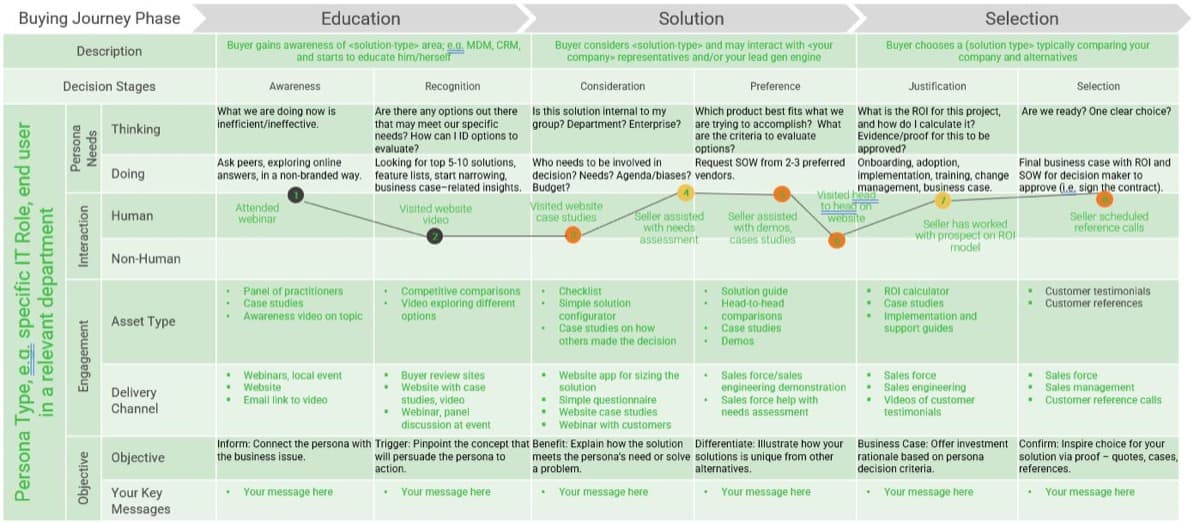
1.3.3 Describe Your Awareness and Lead Gen Engine
- Understand the workings of a typical awareness and lead generation engine. Reference the image of a lead gen engine on the following slide when reviewing our guidance below:
- In our lead scoring example found in the Lead Scoring Workbook, tab 3, “Weight and Test,” we use a software company selling a sales automation solution, and the engagement activities match with the Typical Awareness and Lead Gen Engine found on the following slide. Our goal is to match a visual representation of a lead gen and awareness engine with the activity scoring portion of lead scoring.
- At the top of the Typical Awareness and Lead Generation Engine image, the activities are activated by a team of various roles: digital manager (new web pages), campaign manager (emails and paid media), social media marketer (organic and paid social), and events marketing manager (webinars).
- “Awareness” – On the right, the slide shows additional awareness activities driven by the PR/Corporate Comms and Analyst Relations teams.*
- The calls to action (CTAs) found in the outreach activities are illustrated below the timeline. The CTAs are grouped and are designed to 1) drive profile capture data via a main sales form fill, and 2) drive engagement that corresponds to the Education, Solution, and Selection buyer journey phases outlined on the prior slide. Ensure you have fast paths to get a hot lead – request a demo – directly to Field Sales when profiles score high.
* For guidance on best practices in engaging industry analysts, contact your engagement manager to schedule an inquiry with our expert in this area. during that inquiry, we will share best practices and recommended analyst engagement models.
2 hours
On the following slide:
- Tailor the slide to describe your lead generation engine as you will use it when you get to latter steps to describe the activities in your lead gen engine and weight them for lead scoring.
- Use the template to see what makes up a typical lead gen and awareness building engine. Record your current engine parts and see what you may be missing.
- Note: The “Goal” image in the upper right of the slide is meant as a reminder that marketers should establish a goal for SQLs delivered to Field Sales for each campaign.
SoftwareReviews Advisory Insight:
Marketing’s primary mission is to deliver marketing-influenced wins (MIWs) to the company. Building a compelling awareness and lead gen engine must be done with that goal in mind. Leaders are ruthless in testing – copy, email subjects, website navigation, etc. – to fine-tune the engine and staying highly collaborative with sellers to ensure high value lead delivery.
Typical Awareness and Lead Gen Engine
Understand how a typical lead generation engine works. Awareness activities are included as a reference. Use as a template for campaigns.
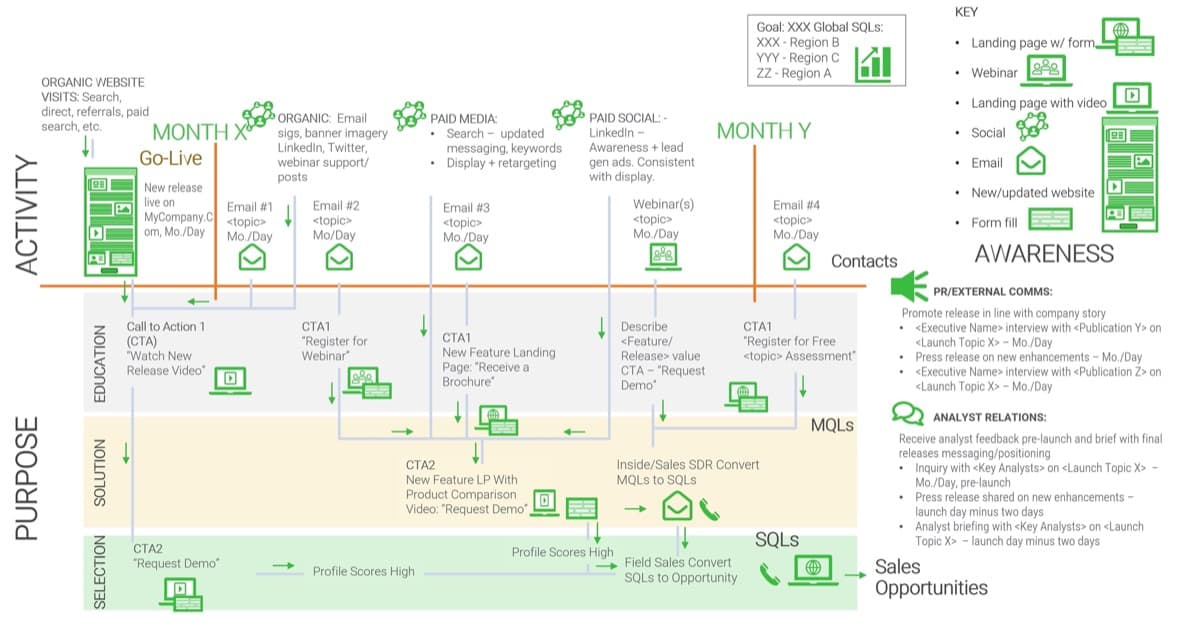
Phase 2
Build and Test Your Lead Scoring Model
Phase 1 | Phase 2 | Phase 3 |
|---|---|---|
1.1 Establish a cross-functional vision for lead scoring 1.2 Asses your tech stack for lead scoring (optional) 1.3 Catalog your buyer journey and lead gen engine assets | 2.1 Start building your lead scoring model 2.2 Identify and verify your IPC and weightings 2.3 Establish key lead generation activities and assets | 3.1 Apply model to your marketing management software 3.2 Test the quality of sales-accepted leads 3.3 Apply advanced methods |
This phase will walk you through the following activities:
- Understand the Lead Scoring Grid and establish thresholds.
- Collaborate with stakeholders on your ICP, apply weightings to profile attributes and values, and test.
- Identify the key activities and assets of your lead gen engine, weight attributes, and run tests.
This phase involves the following participants:
- Field Marketing/Campaign Manager
- Product Marketing
- Sales Leadership/Sales Operations
- Inside Sales leadership
- Marketing Operations/IT
- Digital Platform leadership
Step 2.1
Start Building Your Lead Scoring Model
Activities
2.1.1 Understand the Lead Scoring Grid
2.1.2 Identify thresholds
This step will walk you through the following activities:
- Discuss the concept of the thresholds for scoring leads in each of the various states – “ignore,” “nurture,” “qualify,” “send to sales.”
- Open the Lead Scoring Workbook and validate your own states to suit your organization.
- Arrive at an initial set of threshold scores.
This step involves the following participants:
- Stakeholders
Outcomes of this step
- Stakeholder alignment on stages
- Stakeholder alignment on initial set of thresholds
2.1.1 Understand the Lead Scoring Grid
30 minutes
- Understand how lead scoring works and our grid is constructed.
- Understand the two important areas of the grid and the concept of how the contact’s scores will increase as follows:
- Profile – as the profile attributes of the contact approaches that of the ICP we want to score the contact/prospect higher. Note: Step 1.3 walks you through creating your ICP.
- Engagement – as the contact/prospect engages with the activities (e.g. webinars, videos, events, emails) and assets (e.g. website, whitepapers, blogs, infographics) in our lead generation engine, we want to score the contact/prospect higher. Note: You will describe your engagement activities in this step.
- Understand how thresholds work:
- Threshold percentages, when reached, trigger movement of the contact from one state to the next – “ignore,” “nurture,” “qualify with Inside Sales,” and “send to sales.”
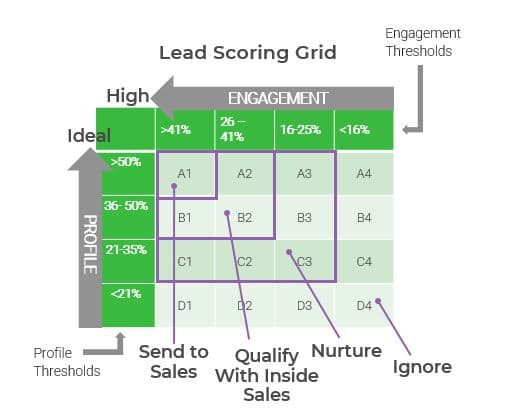
2.1.2 Identify thresholds
30 minutes
We have set up a model Lead Scoring Grid – see Lead Scoring Workbook, tab 2, “Identify Thresholds.”
Set your thresholds within the Lead Scoring Workbook:
- Set your threshold percentages for ”Profile” and “Engagement.”
- You will run test scenarios for each in later steps.
- We suggest you start with the example percentages given in the Lead Scoring Workbook and plan to adjust them during testing in later steps.
- Define the “Send to Sales,” “Qualify With Inside Sales,” “Nurture,” and “Ignore” zones.
SoftwareReviews Advisory Insight:
Clarify that all-important threshold for when a lead passes to your expensive and time-starved outbound sellers.
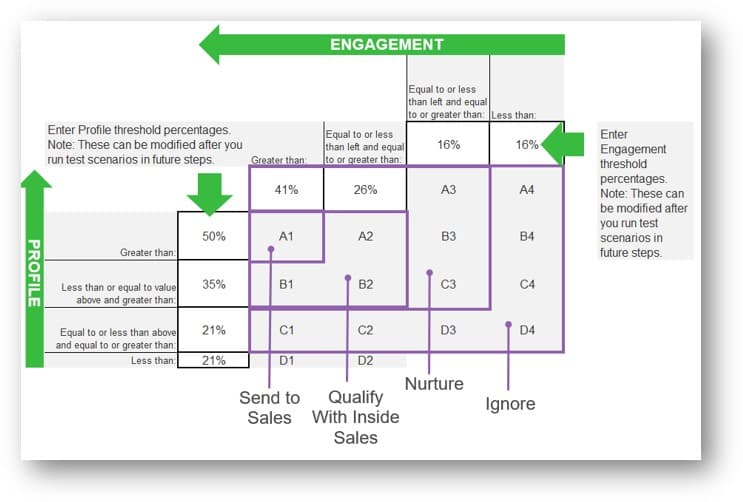
Step 2.2
Identify and Verify Your Ideal Customer Profile and Weightings
Activities
2.2.1 Identify your ideal customer profile
2.2.2 Run tests to validate profile weightings
This step will walk you through the following activities:
- Identify the attributes that compose the ICP.
- Identify the values of each attribute and their weightings.
- Test different contact profile scenarios against what actually makes sense.
- Adjust weightings if needed.
This step involves the following participants:
- Stakeholders
Outcomes of this step
- Stakeholder alignment on ICP
- Stakeholder alignment on weightings given to attributes
- Tested results to verify thresholds and cores
2.2.1 Identify your ideal customer profile
Collaborate with stakeholders to understand what attributes best describe your ICP. Assign weightings and subratings.
2 hours
- Choose attributes such as job role, organization type, number of employees/potential seat holders, geographical location, interest area, etc., that describe the ideal profile of a target buyer. Best practice sees marketers choosing attributes based on real wins.
- Some marketers compare the email domain of the contact to a target list of domains. In the Lead Scoring Workbook, tab 3, “Weight and Test,” we provide an example profile for a “Sales Automation Software” ICP.
- Use the workbook as a template, remove our example, and create your own ICP attributes. Then weight the attributes to add up to 100%. Add in the attribute values and weight them. In the next step you will test scenarios.
SoftwareReviews Advisory Insight:
Marketers who align with colleagues in areas such as Product Marketing, Sales, Inside Sales, Sales Training/Enablement, and Product Managers and document the ICP give their organizations a greater probability of lead generation success.
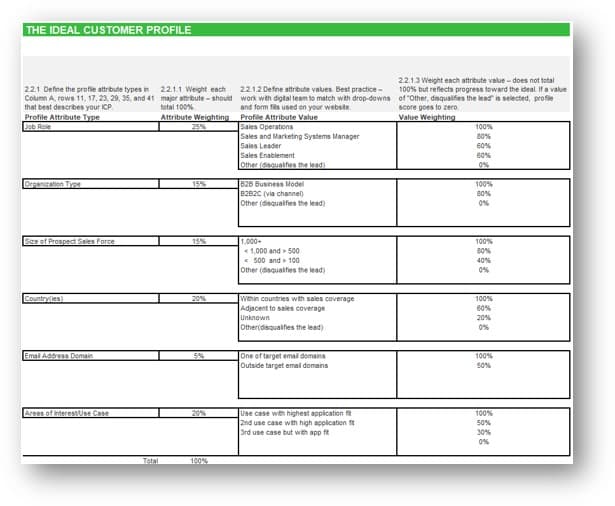
2.2.2 Run tests to validate profile weightings
Collaborate with stakeholders to run different profile scenarios. Validate your model including thresholds.
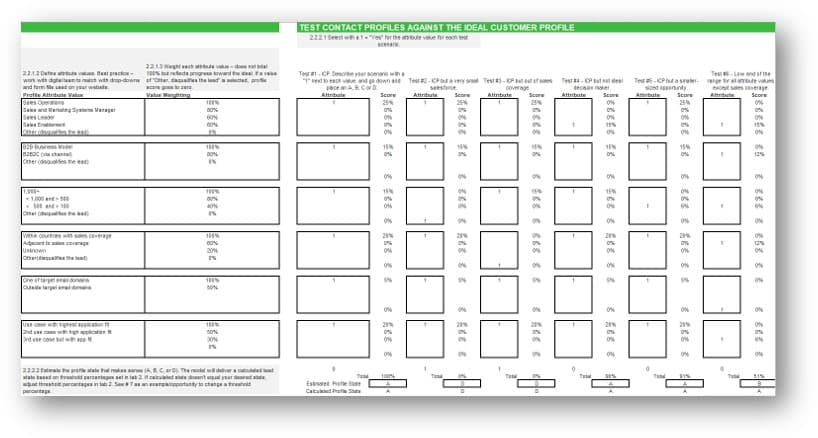
SoftwareReviews Advisory Insight:
Keep your model simple in the interest of fast implementation and to drive early learnings. The goal is not to be perfect but to start iterating toward success. You will update your scoring model even after going into production.
2 hours
- Choose scenarios of contact/lead profile attributes by placing a “1” in the “Attribute” box shown at left.
- Place your estimate of how you believe the profile should score in the box to the right of “Estimated Profile State.” How does the calculated state, beneath, compare to the estimated state?
- In cases where the calculated state differs from your estimated state, consider weighting the profile attribute differently to match.
- If you find estimates and calculated states off dramatically, consider changing previously determined thresholds in tab 2, “Identify Thresholds.” Test multiple scenarios with your team.
Step 2.3
Establish Key Lead Generation Activities and Assets
Activities
2.3.1 Establish activities, attribute values, and weights
2.3.2 Run tests to evaluate activity ratings
This step will walk you through the following activities:
- Identify the activities/asset types in your lead gen engine.
- Weight each attribute and define values to score for each one.
- Run tests to ensure your model makes sense.
This step involves the following participants:
- Stakeholders
- Project sponsors and leaders
Outcomes of this step
- Final stakeholder alignment on which assets compose your lead generation engine
- Scoring model tested
2.3.1 Establish activities, attribute values, and weights
2 hours
- Catalog the assets and activities that compose your lead generation engine outlined in Activity 1.3.3. Identify their attribute values and weight them accordingly.
- Consider weighting attributes and values according to how close that asset gets to conveying your ideal call to action. For example, if your ideal CTA is “schedule a demo” and the “click” was submitted in the last seven days, it scores 100%. Take time decay into consideration. If that same click was 60 days ago, it scores less – maybe 60%.
- Different assets convey different intent and therefore command different weightings; a video comparing your offering against the competition, considered a down funnel asset, scores higher than the company video, considered a top-of-the-funnel activity and “awareness.”
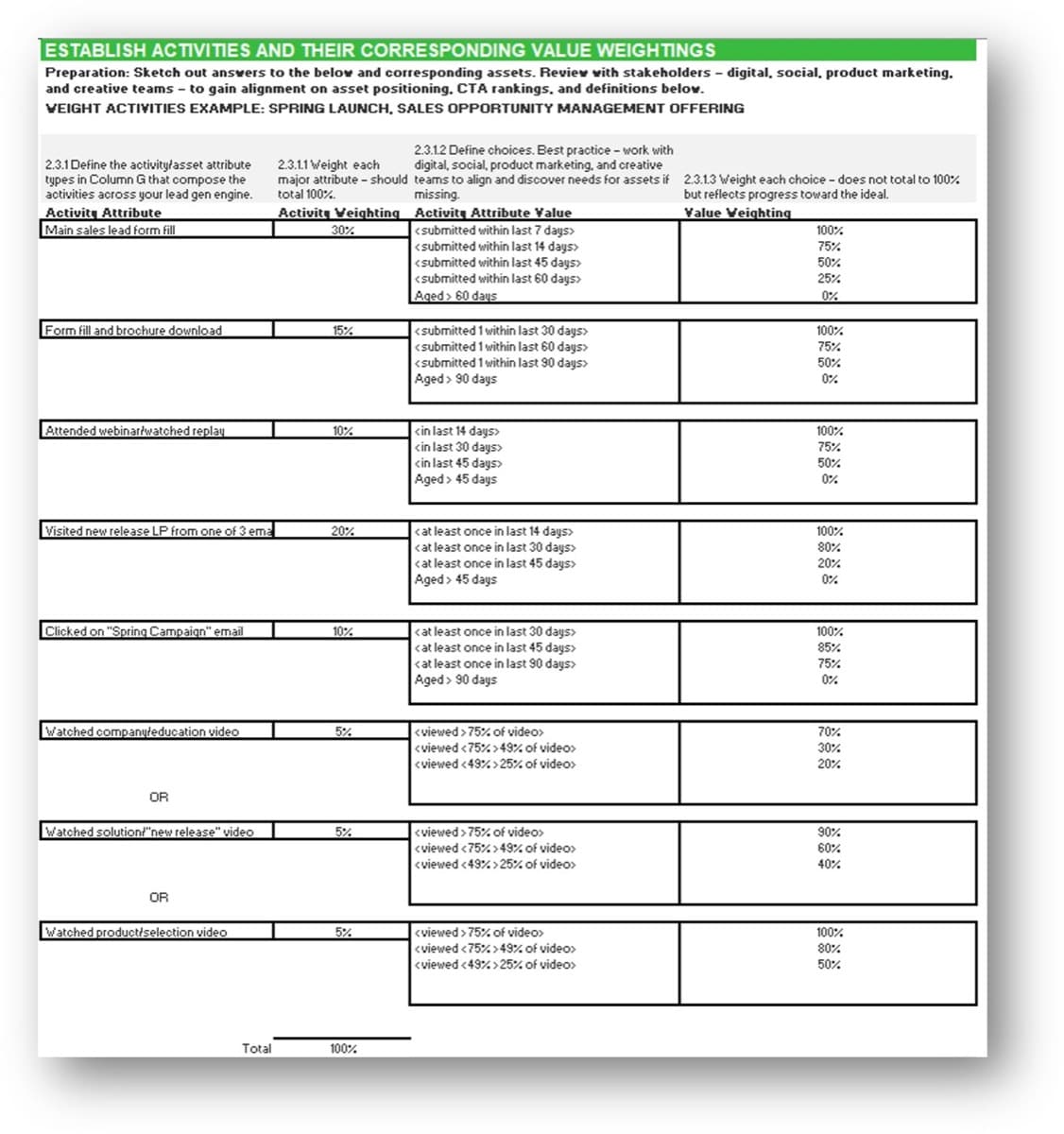
2.3.2 Run tests to validate activity weightings
Collaborate with stakeholders to run different engagement scenarios. Validate your model including thresholds.
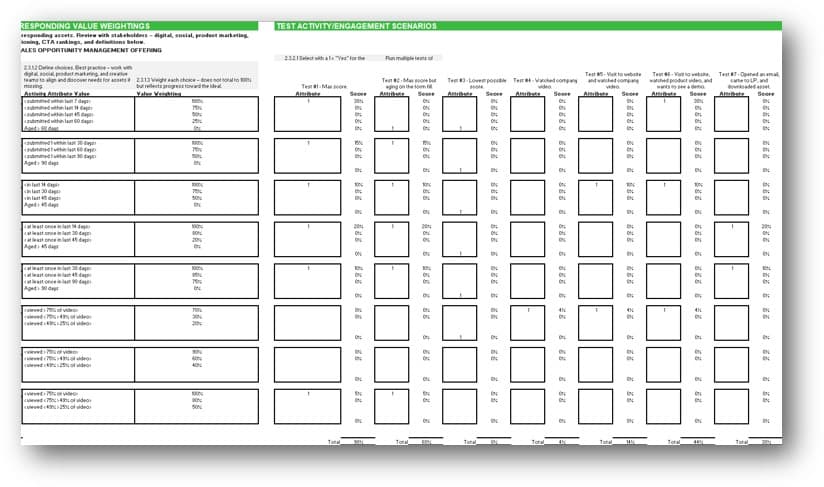
SoftwareReviews Advisory Insight:
Use data from actual closed deals and the underlying activities to build your model – nothing like using facts to inform your key decisions. Use common sense and keep things simple. Then update further when data from new wins appears.
2 hours
- Test scenarios of contact engagement by placing a “1” in the “Attribute” box shown at left.
- Place your estimate of how you believe the engagement should score in the box to the right of “Estimated Engagement State.” How does the calculated state, beneath, compare to the estimated state?
- In cases where the calculated state differs from your estimated state, consider weighting the activity attribute differently to match.
- If you find that the estimates and calculated states are off dramatically, consider changing previously determined thresholds in tab 2, “Identify Thresholds.” Test multiple scenarios with your team.
Phase 3
Apply Your Model to Marketing Apps and Go Live With Better Qualified Leads
Phase 1 | Phase 2 | Phase 3 |
|---|---|---|
1.1 Establish a cross-functional vision for lead scoring 1.2 Asses your tech stack for lead scoring (optional) 1.3 Catalog your buyer journey and lead gen engine assets | 2.1 Start building your lead scoring model 2.2 Identify and verify your IPC and weightings 2.3 Establish key lead generation activities and assets | 3.1 Apply model to your marketing management software 3.2 Test the quality of sales-accepted leads 3.3 Apply advanced methods |
This phase will walk you through the following activities:
- Apply model to your marketing management/campaign management software.
- Get better qualified leads in the hands of sellers.
- Apply lead nurturing and other advanced methods.
This phase involves the following participants:
- Field Marketing/Campaign Manager
- Sales Leadership/Sales Operations
- Inside Sales leadership
- Marketing Operations/IT
- Digital Platform leadership
Step 3.1
Apply Model to Your Marketing Management Software
Activities
3.1.1 Apply final model to your lead management software
This step will walk you through the following activities:
- Apply the details of your scoring model to the lead management software.
This step involves the following participants:
- Stakeholders
- Project sponsors and leaders
Outcomes of this step
- Marketing management software or campaign management application is now set up/updated with your lead scoring approach.
3.1.1 Apply final model to your lead management software
Now that your model is complete and ready to go into production, input your lead scoring parameters into your lead management software.
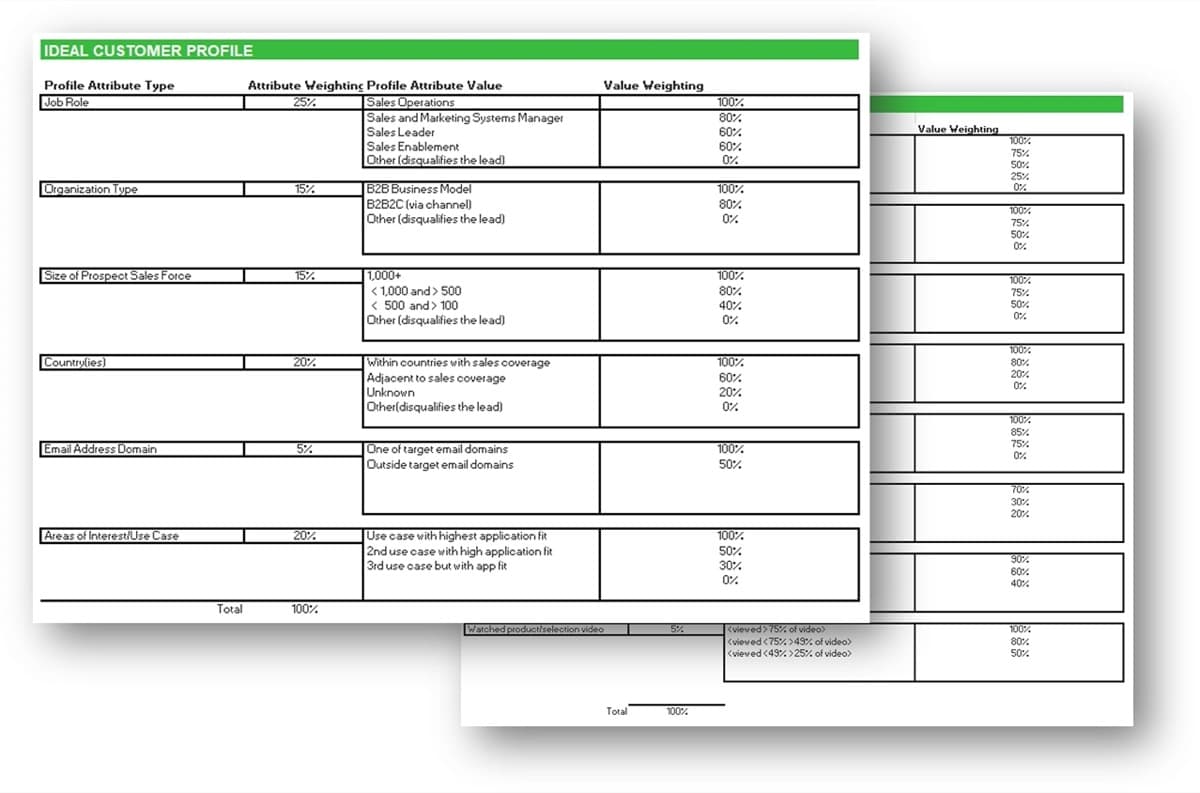
3 hours
- Go to the Lead Scoring Workbook, tab 4, “Model Summary” for a formatted version of your lead scoring model. Double-check print formatting and print off a copy.
- Use the copy of your model to show to prospective technology providers when asking them to demonstrate their lead scoring capabilities.
- Once you have finalized your model, use the printed output from this tab to ease your process of transposing the corresponding model elements into your lead management software.
Step 3.2
Test the Quality of Sales-Accepted Leads
Activities
3.2.1 Achieve sales lead acceptance
3.2.2 Measure and optimize
This step will walk you through the following activities:
- Suggest that the Inside Sales and Field Sales teams should assess whether to sign off on quality of leads received.
- Campaign managers and stakeholders should now be able to track lead status more effectively.
This step involves the following participants:
- Stakeholders
- Project sponsors and leaders
Outcomes of this step
- Sales leadership should be able to sign off that leads are better qualified.
- With marketing pipeline analytics in place, campaigners can start to measure lead flow and conversion rates.
3.2.1 Achieve sales lead acceptance
Collaborate with sellers to validate your lead scoring approach.
1 hour
- Gather a set of SQLs – leads that have been qualified by Inside Sales and delivered to Field Sales. Have Field Sales team members convey whether these leads were properly qualified.
- Where leads are deemed not properly qualified, determine if the issue was a) a lack of proper qualification by the Inside Sales team, or b) the lead generation engine, which should have further nurtured the lead or ignored it outright.
- Work collaboratively with Inside Sales to update your lead scoring model and/or Inside Sales practice.
Stage | Characteristics | Actions |
Contact |
| Nurture SDR Qualify Send to Sales Close |
MQL |
| |
SQL |
| |
Oppt’y |
| |
Win |
|
SoftwareReviews Advisory Insight:
Marketers that collaborate with Sales – and in this case, a group of sellers as a sales advisory team – well in advance of sales acceptance to design lead scoring will save time during this stage, build trust with sellers, and make faster decisions related to lead management/scoring.
3.2.2 Measure and optimize
Leverage analytics that help you optimize your lead scoring methodology.
Ongoing
- Work with Marketing Ops/IT team to design and implement analytics that enable you to:
- Meet frequently with your stakeholder team to review results.
- Learn from the wins: see how they actually scored and adjust thresholds and/or asset/activity weightings.
- Learn from losses: fix ineffective scoring, activities, assets, form-fill strategies, and engagement paths.
- Test from both wins and losses if demographic weightings are delivering accurate scores.
- Analyze those high scoring leads that went right to sellers but did not close. This could point to a sales training or enablement challenge.
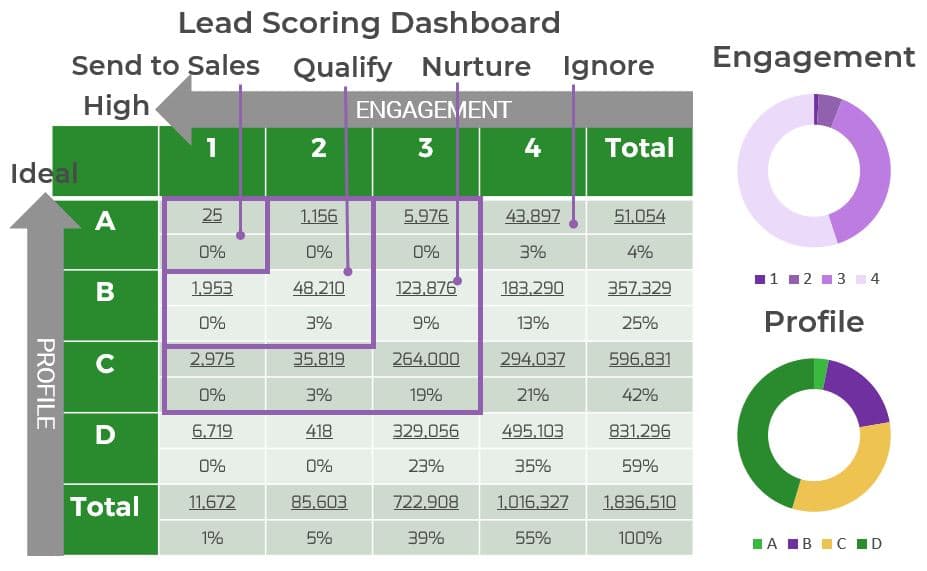
Analytics will also drive additional key insights across your lead gen engine:
- Are volumes increasing or decreasing? What percentage of leads are in what status (A1-D4)?
- What nurturing will re-engage stalled leads that score high in profile but low in engagement (A3, B3)?
- Will additional profile data capture further qualify leads with high engagement (C1, C2)?
- And beyond all of the above, what leads move to Inside Sales and convert to SQLs, opportunities, and eventually marketing-influenced wins?
Step 3.3
Apply Advanced Methods
Activities
3.3.1 Employ lead nurturing strategies
3.3.2 Adjust your model over time to accommodate more advanced methods
This step will walk you through the following activities:
- Apply lead nurturing to your lead gen engine.
- Adjust your engine over time with more advanced methods.
This step involves the following participants:
- Stakeholders
- Project sponsors and leaders
Outcomes of this step
- Marketers can begin to test lead nurturing strategies and other advanced methods.
3.3.1 Employ lead nurturing strategies
A robust content marketing competence with compelling assets and the capture of additional profile data for qualification are key elements of your nurturing strategy.
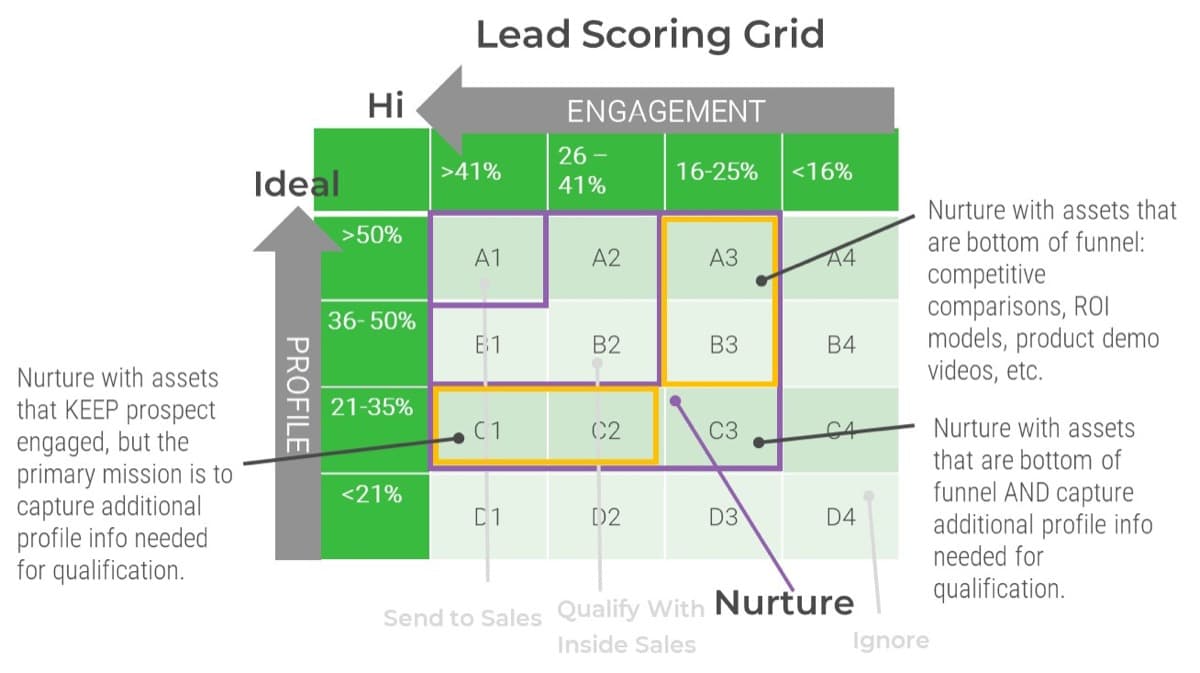
SoftwareReviews Advisory Insight:
Nurturing success combines the art of crafting engaging copy/experiences and the science of knowing just where a prospect is within your lead gen engine. Great B2B marketers demonstrate the discipline of knowing when to drive engagement and/or additional profile attribute capture using intent while not losing the prospect to over-profiling.
Ongoing
- The goal of lead nurturing is to move the collection of contacts/leads that are scoring, for example, in the A3, B3, C1, C2, and C3 cells into A2, B2, and B1 cells.
- How is this best done? To nurture leads that are A3 and B3, entice the prospect with engagement that leads to the bottom of funnel – e.g. “schedule a demo” or “schedule a consultation” via a compelling asset. See the example on the following slide.
- To nurture C1 and C2, we need to qualify them further, so entice with an asset that leads to deeper profile knowledge.
- For C3 leads, we need both profile and activity nurturing.
Lead nurturing example
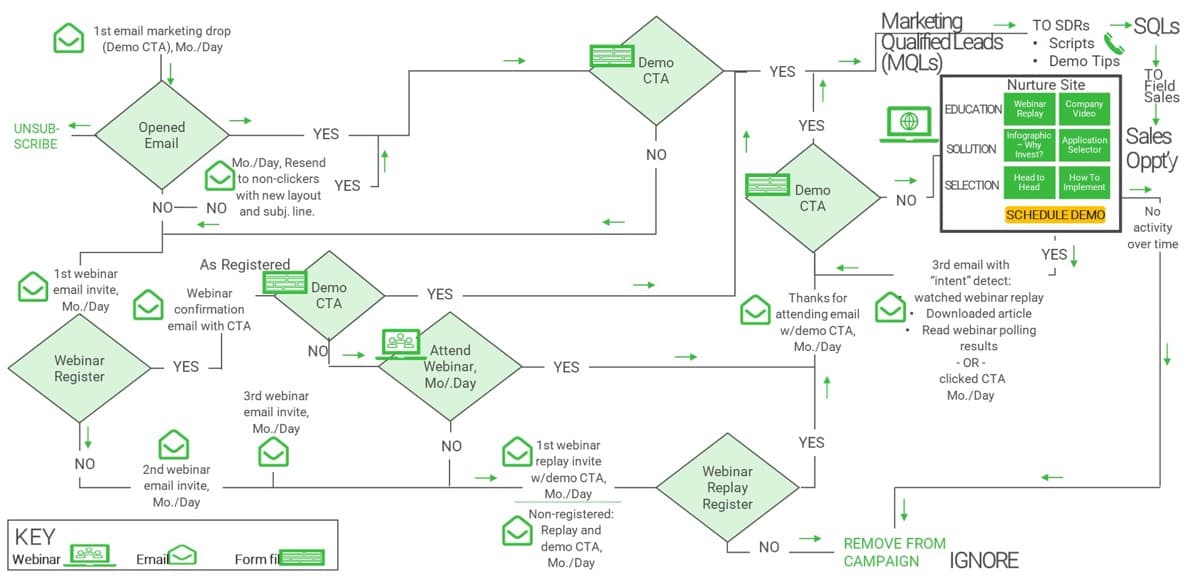
SoftwareReviews Advisory Insight:
When nurturing, choose/design content as to what “intent” it satisfies. For example, a head-to-head comparison with a key competitor signals “Selection” phase of the buyer journey. Content that helps determine what app-type to buy signals “Solution”. A company video, or a webinar replay, may mean your buyer is “educating themselves.
3.3.2 Adjust your model over time to accommodate more advanced methods
When getting started or within a smaller marketing team, focus on the basics outlined thus far in this blueprint. Larger and/or more experienced teams are able to employ more advanced methods.
Ongoing
Advanced Methods
- Invest in technologies that interpret lead scores and trigger next-step actions, especially outreach by Inside and/or Field Sales.
- Use the above to route into nurturing environments where additional engagement will raise scores and trigger action.
- Recognize that lead value decays with time to time additional outreach/activities and to reduce lead scores over time.
- Always be testing different engagement, copy, and subsequent activities to optimize lead velocity through your lead gen engine.
- Build intent sensitivity into engagement activities; e.g. test if longer demo video engagement times imply ”contact me for a demo” via a qualification outreach. Update scores manually to drive learnings.
- Vary engagement paths by demographics to deliver unique digital experiences. Use firmographics/email domain to drive leads through a more tailored account-based marketing (ABM) experience.
- Reapply learnings from closed opportunities/wins to drive updates to buyer journey mapping and your ICP.
Frequently used acronyms
ABM |
Account-Based Marketing |
|---|---|
B2B |
Business to Business |
CMO |
Chief Marketing Officer |
CRM |
Customer Relationship Management |
ICP |
Ideal Customer Profile |
MIW |
Marketing-Influenced Win |
MQL |
Marketing-Qualified Lead |
SDR |
Sales Development Representative |
SQL |
Sales-Qualified Lead |
Works cited
Arora, Rajat. “Mining the Real Gems from you Data – Lead Scoring and Engagement Scoring.” LeadSquared, 27 Sept. 2014. Web.
Doyle, Jen. “2012 B2B Marketing Benchmark Report: Research and insights on attracting and converting the modern B2B buyer.” MarketingSherpa, 2012. Web.
Doyle, Jen, and Sergio Balegno. “2011 MarketingSherpa B2B Marketing Benchmark Survey: Research and Insights on Elevating Marketing Effectiveness from Lead Generation to Sales Conversion.” MarketingSherpa, 2011.
Kirkpatrick, David. “Lead Scoring: CMOs realize a 138% lead gen ROI … and so can you.” marketingsherpa blog, 26 Jan 2012. Web.
Moser, Jeremy. “Lead Scoring Is Important for Your Business: Here’s How to Create Scoring Model and Hand-Off Strategy.” BigCommerce, 25 Feb. 2019. Web.
Strawn, Joey. “Why Lead Scoring Is Important for B2Bs (and How You Can Implement It for Your Company.” IndustrialMarketer.com, 17 Aug. 2016. Web.